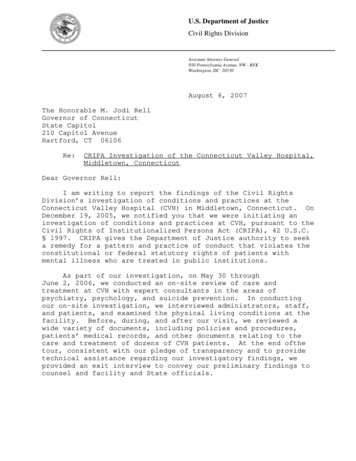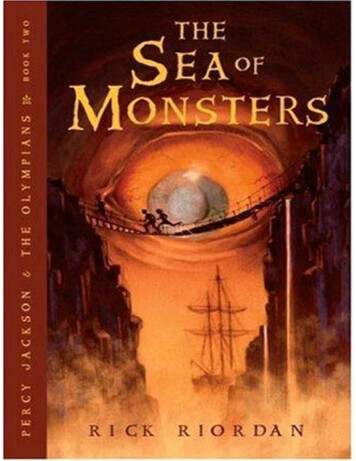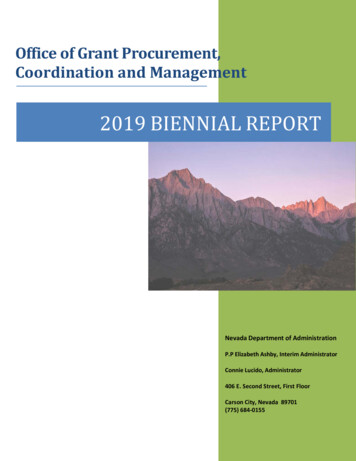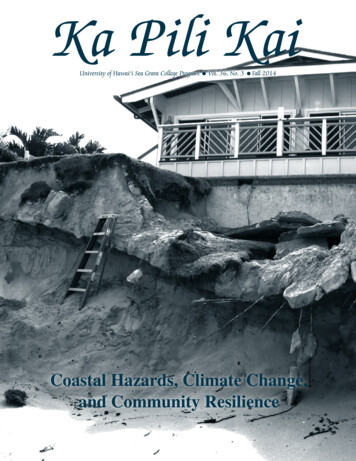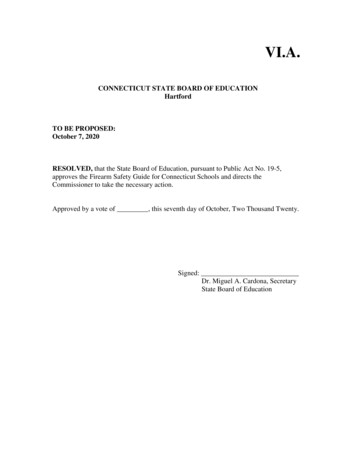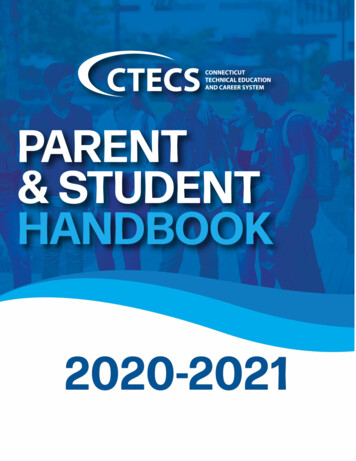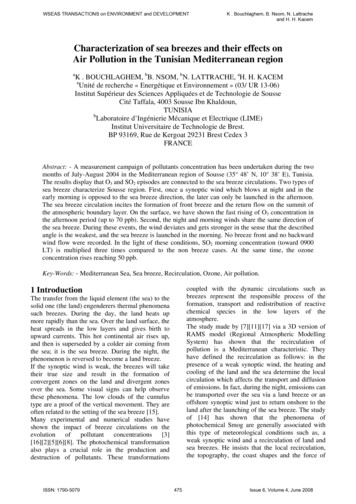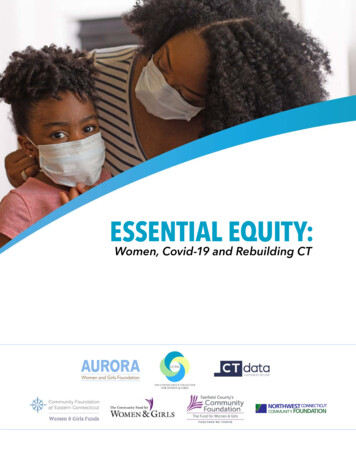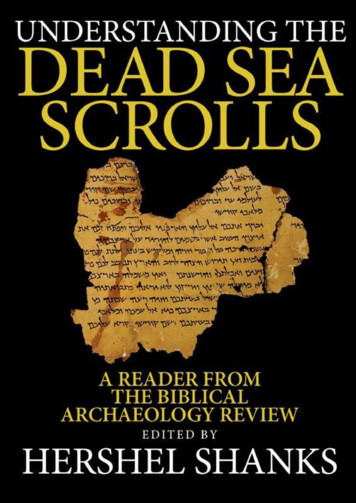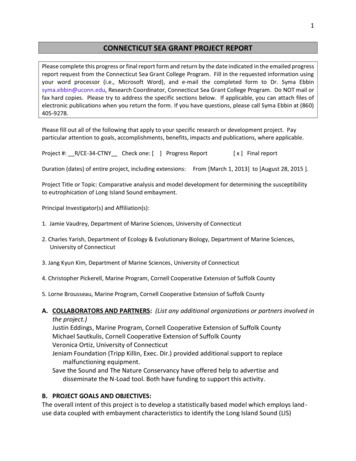
Transcription
1CONNECTICUT SEA GRANT PROJECT REPORTPlease complete this progress or final report form and return by the date indicated in the emailed progressreport request from the Connecticut Sea Grant College Program. Fill in the requested information usingyour word processor (i.e., Microsoft Word), and e-mail the completed form to Dr. Syma Ebbinsyma.ebbin@uconn.edu, Research Coordinator, Connecticut Sea Grant College Program. Do NOT mail orfax hard copies. Please try to address the specific sections below. If applicable, you can attach files ofelectronic publications when you return the form. If you have questions, please call Syma Ebbin at (860)405-9278.Please fill out all of the following that apply to your specific research or development project. Payparticular attention to goals, accomplishments, benefits, impacts and publications, where applicable.Project #: R/CE-34-CTNY Check one: [ ] Progress ReportDuration (dates) of entire project, including extensions:[ x ] Final reportFrom [March 1, 2013] to [August 28, 2015 ].Project Title or Topic: Comparative analysis and model development for determining the susceptibilityto eutrophication of Long Island Sound embayment.Principal Investigator(s) and Affiliation(s):1. Jamie Vaudrey, Department of Marine Sciences, University of Connecticut2. Charles Yarish, Department of Ecology & Evolutionary Biology, Department of Marine Sciences,University of Connecticut3. Jang Kyun Kim, Department of Marine Sciences, University of Connecticut4. Christopher Pickerell, Marine Program, Cornell Cooperative Extension of Suffolk County5. Lorne Brousseau, Marine Program, Cornell Cooperative Extension of Suffolk CountyA. COLLABORATORS AND PARTNERS: (List any additional organizations or partners involved inthe project.)Justin Eddings, Marine Program, Cornell Cooperative Extension of Suffolk CountyMichael Sautkulis, Cornell Cooperative Extension of Suffolk CountyVeronica Ortiz, University of ConnecticutJeniam Foundation (Tripp Killin, Exec. Dir.) provided additional support to replacemalfunctioning equipment.Save the Sound and The Nature Conservancy have offered help to advertise anddisseminate the N-Load tool. Both have funding to support this activity.B. PROJECT GOALS AND OBJECTIVES:The overall intent of this project is to develop a statistically based model which employs landuse data coupled with embayment characteristics to identify the Long Island Sound (LIS)
2embayments at greatest risk for exhibiting symptoms of eutrophication and to identify the mainsources of nitrogen (N) to these embayments. This statistical model will yield the relationshipbetween the nitrogen load (N load), estuarine freshwater flushing time, and eutrophic status. Ifthis simple approach does not yield significant results, additional forcing factors will beincluded. The specific objectives include:1. QAPP development.2. Calculate N load estimates for a minimum of 50 embayments using a published model whichrelates land-use in the watershed to the total N load for the embayment.3. Calculate estimates of the freshwater flushing time for a minimum of 50 embayments usingtwo methods: (1) a modified tidal prism method and (2) a simplified method developed inembayments which relates estuarine length and surface area to freshwater flushing time.4. Using the output from Objectives 2 & 3, a published model will be used to estimate thedissolved inorganic nitrogen (DIN) concentration in the embayments. This value will be usedto quantify the error of the model outputs predicting N load.5. Field-based evaluation of ten embayments in New York (NY) and Connecticut (CT) forsusceptibility to hypoxia and primary producer community composition.6. Apply field data to indices developed to identify the trophic status of estuaries. We will usetwo methods: one developed by the EPA and one developed by NOAA.7. Develop a statistical model using multivariate analysis techniques to relate the calculated Nload (#2), fresh water flushing time (#3), and estuarine trophic status (#6). Developpredictions as to which of the unsampled LIS embayments are most likely to experiencesymptoms of eutrophication.8. Using the predictions of eutrophication risk for 50 embayments (#7), develop “report cards”for each embayment detailing potential environmental issues and the likeliest causes. Thesereport cards will be presented to the LISS STAC, community groups and other groups whoprovided data, NY Sea Grant, CT Sea Grant, Citizen’s Campaign for the Environment (CT andNY) and Save the Sound / CT Fund for the Environment.C. PROGRESS: (Summarize progress relative to project goals and objectives. Highlightoutstanding accomplishments, outreach and education efforts; describe problemsencountered and explain any delays.)Progress is described based on objectives presented in section B.:1. QAPP Development. The QAPP was approved on 11/7/2013. Progress on the approval ofthe QAPP was originally hindered by the government shut down. However, preliminaryapproval to proceed with the summer 2013 field work and time critical lab analyses(macrophyte processing for biomass, total suspended solids, chlorophyll analysis) wasreceived on 7/19/2013.2. Calculate N load to embayments. Work is complete. The results have been presented ina number of different venues, as listed under the presentations section of this report.3. Calculate flushing times. Work is complete. Flushing time is a crude approximation.While it was useful, we do not consider the results accurate enough to be appliedbeyond the work presented in this report.
34. Calculate predicted dissolved inorganic nitrogen in the embayments, for comparing tofield data. Work is complete. Results were less than satisfactory, work beyond the scopeof this project is required to better quantify in-estuarine nitrogen cycling specific to eachembayment.5. Field work in 10 embayments. Work is complete.6. Identify trophic status of embayments where field sampling occurred. Work is complete.7. Develop a statistical model linking N load and trophic status. Work is complete. Theresults are tenuous, as most sites scored the same for eutrophic status - highlyimpacted. We have provided alternate methods for estimating trophic status from Nload.8. Develop report cards for embayments. Results of this task will be available in thetechnical report. However, we have change the name to “embayment portfolios” asthey are not true report cards. Also, Long Island Sound has a report card processunderway and we did not want the two efforts to be confused.D. PROJECT PUBLICATIONS, PRODUCTS AND PATENTS: (Include published materials withcomplete references, as well as those which have been submitted but not yet published andthose in press. Please attach electronic versions of any journal articles not previouslyprovided.)Journal Articles:Basso G, Vaudrey JMP, O'Brien K, Barrett J (in review) Landscape scale habitatassessment of the Long Island Sound Estuary, USA.Conference Papers and Presentations:Vaudrey, J.M.P. (2016) Nitrogen Loads to Long Island Sound’s Coves and Embayments. invitedpresentation. 2016 Advanced Master Gardener Coastal Certificate Program.Vaudrey, J.M.P., C. Yarish, C. Pickerell, L. Brousseau, J. Eddings, J.K. Kim, M. Sautkulis (2016)Embayment Nitrogen Loads for Long Island Sound – Utilizing the Excel Model InterfaceWorkshop. EPA Region 2 and Suffolk County New York, Cold Spring Harbor, NY.Vaudrey, J.M.P. (2016) Water Quality: From Ground to Sound. panelist, Mystic Aquarium’sConservation in Action Lecture Series, Mystic, CT. Co-panelists: David Prescott, Save the Bay;Chris Freeman, Clean Up Sound and Harbor.Vaudrey, J.M.P., C. Yarish, C. Pickerell, L. Brousseau, J. Eddings, J.K. Kim, M. Sautkulis (2016)3/2/16 “Embayment Nitrogen Loads for Long Island Sound.” EPA Region 2, New York City,NY. (with C. Yarish, C. Pickerell, L. Brousseau, J. Eddings, J.K. Kim, M. Sautkulis)Vaudrey, J.M.P., C. Yarish, C. Pickerell, L. Brousseau, J. Eddings, J.K. Kim, M. Sautkulis (2016)2/4/16 “Embayment Nitrogen Loads for Saugatuck River” invited presentation, SaugatuckWater Quality Symposium, hosted by The Nature Conservancy. (with C. Yarish, C. Pickerell,L. Brousseau, J. Eddings, J.K. Kim, M. Sautkulis)
4Vaudrey, J.M.P., C. Yarish, C. Pickerell, L. Brousseau, J. Eddings, J.K. Kim, M. Sautkulis (2016)Embayment Eutrophic Conditions in Long Island Sound, invited presentation, Save the Soundand the Long Island Sound Report Card Initiative Workgroup.Vaudrey, J.M.P., C. Yarish, C. Pickerell, L. Brousseau, J. Eddings, J.K. Kim, M. Sautkulis (2015)Embayment Nitrogen Loads for Long Island Sound, invited presentation, Long Island SoundStudy’s Management Committee, Housatonic Community College, CT.Vaudrey, J.M.P., C. Yarish, C. Pickerell, L. Brousseau, J. Eddings, J.K. Kim, M. Sautkulis (2015)Embayment Nitrogen Loads for Long Island Sound, invited presentation, Long Island SoundStudy’s Citizen Advisory Committee, Housatonic Community College, CT.Vaudrey, J.M.P. (2015) panelist for 15th Annual Connecticut League of Conservation VotersEnvironmental Summit. Hartford, CT.Vaudrey, J.M.P., C. Yarish, C. Pickerell, L. Brousseau, J. Eddings, J.K. Kim (2015) Nitrogen Loads toLong Island Sound’s Coves and Embayments. invited presentation. Long Island Sound StudyCitizen Advisory Committee December Meeting.Vaudrey, J.M.P. (2015) Nitrogen Loads to Long Island Sound’s Coves and Embayments. invitedpresentation. 2015 Advanced Master Gardener Coastal Certificate Program.Brousseau, L., J.M.P. Vaudrey, C. Yarish, C. Pickerell, J. Eddings, J.K. Kim (2015) EmbaymentNitrogen Loads. invited presentation, New York State DEC Groundwater symposium.Vaudrey, J.M.P., C. Yarish, C. Pickerell, L. Brousseau, J. Eddings, J.K. Kim (2015) EmbaymentNitrogen Loads for Long Island Sound. invited presentation, Long Island Sound Funder’sCollaborative.Vaudrey, J.M.P., C. Yarish, C. Pickerell, L. Brousseau, J. Eddings, J.K. Kim (2015) EmbaymentNitrogen Loads. invited presentation, joint meeting of the Long Island Sound Study’s Scienceand Technical Advisory Committee and Long Island Sound Study’s Citizen AdvisoryCommittee.Vaudrey, J.M.P., C. Yarish, C. Pickerell, L. Brousseau, J. Eddings, J.K. Kim (2015) EmbaymentRapid Assessment and Evaluation of Eutrophic Status. invited presentation, New York StateDEC and Save the Sound.Krumholz, J. and J.M.P. Vaudrey, C. Yarish, C. Pickerell, L. Brousseau, J. Eddings, J.K. Kim (2015)Embayment Nitrogen Loads. invited presentation, Long Island Sound Study’s CitizenAdvisory Committee.Vaudrey, J.M.P. (2015) Dead Zones, Wetlands, Ocean Acidification and Wildlife: NitrogenPollution’s Path of Destruction. invited panelist at the Long Island Sound Citizen’s Summit.Co-panelists: H. Baumann (UConn) & L. Suatoni (NRDC); J. Varekamp (Wesleyan U.)moderating.Vaudrey, J.M.P. (2015) Eutrophication in Long Island Sound Embayments: using troubled watersas a cross-disciplinary classroom. invited presentation. UConn ECE Experience.Dostie, A. and J.M.P. Vaudrey (2014) Characterization Of The Extent And Source Of NutrientsSupporting A Massive Macroalgae Bloom In Little Narragansett Bay, CT. New EnglandEstuarine Research Society Fall Meeting.
5Leamy, C and J.M.P. Vaudrey (2014) Extent and Severity of Late Summertime Hypoxia inConnecticut And New York Embayments of Long Island Sound. New England EstuarineResearch Society Fall Meeting.Vaudrey, J.M.P., C. Yarish, C. Pickerell, L. Brousseau, J. Eddings, J.K. Kim (2014) Nitrogen Loads toLong Island Sound’s Coves and Embayments. invited presentation. 2014 Advanced MasterGardener Coastal Certificate Program.Vaudrey, J.M.P., C. Yarish, C. Pickerell, L. Brousseau, J. Eddings, J.K. Kim (2014) EmbaymentNitrogen Loads. invited presentation, LISS STAC.Vaudrey, J.M.P., C. Yarish, C. Pickerell, L. Brousseau, J. Eddings, J.K. Kim (2014) Eutrophiccondition and habitat status in Connecticut and New York embayments of Long Island Sound.invited presentation, CT DEEP’s Niantic Nitrogen Work Group.Vaudrey, J.M.P., C. Yarish, C. Pickerell, L. Brousseau, J. Eddings, J.K. Kim (2014) Eutrophiccondition and habitat status in Connecticut and New York embayments of Long Island Sound.invited presentation, Southern Connecticut State University.Vaudrey, J.M.P. (2014) The Breathing of the Bays: a journey into green water. invitedpresentation, Faulkners Light Brigade Lecture Series, Guilford, CT.Vaudrey, J.M.P. and C. Yarish (2013) Using Nitrogen Budgets as a Tool to More EffectivelyManage Long Island Sound Embayments. 2nd Workshop on Using Cultivated Seaweed andShellfish for Nutrient Bioextraction in LIS and the Bronx River Estuary, Mamaroneck, NY.Vaudrey, J.M.P. and C. Yarish (2013) Nitrogen loading to embayments of Long Island Sound:method review and potential utility to management. Presentation to the Long IslandFunders Collaborative Meeting, New York City, NY. 01 Mar 2013.Proceedings or book chapters:Websites, Software, etc.:LongIslandSound NLoadingModel.xlsx - The nitrogen load model available for use bystakeholders to compare sites, investigate sources and trends, and run scenarios.NLM.mat - The nitrogen lading model in a MatLab format, for academic researchpurposes.GIS layers associated with the NLMTechnical Reports:Vaudrey, J.M.P. for University of Connecticut and Cornell Cooperative Extension of SuffolkCounty. Comparative analysis and model development for determining the susceptibility toeutrophication of Long Island Sound embayments. QAPP Version 2 – September 9, 2013.EPA identifier RFA#: 13110.Comparative analysis and model development for determining the susceptibility toeutrophication of Long Island Sound embayments - final technical report. Appendicesinclude embayment portfolios.Other Products (including popular articles):
6Zaretsky, M. (8/4/13) Low oxygen levels present even in bays in eastern estuary, UConnresearchers find. interview, article, and photos for the New Haven searcher-studies-l-isound-oxygen/#1)Publications planned / in progress: Eutrophic status in Long Island Sound embayments. Patterns of Nitrogen Loads to embayments – targeting NPS reductions Macrophyte C:N as an indicator of N-Load and eutrophic status Using N-Load and flushing time to predict eutrophic status in embayments andtarget management actions Embayments out of balance – regime shifts related to nitrogen loadsPatents: (List those awarded or pending as a result of this project.)E. FUNDS LEVERAGED: (If this Sea Grant funding facilitated the leveraging of additionalfunding for this or a related project, note the amount and source below.) 5,000 received by Marine Science Bachelor’s of Science student, Amanda Dostie. Source:UConn IDEA Grant 2014. Project Title: Tracing the Nutrition Driving Cladophora sp.Dominance in Little Narragansett Bay 1,000 received by Marine Science Master’s Student, Rachel Perry. Source: ConnecticutAssociation of Wetland Scientists. Project Title: Bioavailability of organic nitrogenentering small, shallow embayments: when, where, and how much?F. STUDENTS: (Document the number and type of students supported by this project.)Note: “Supported” means supported by Sea Grant through financial or other means, such as Sea Grant federal,match, state and other leveraged funds. If a student volunteered time on this project, please note the numberof volunteer hours below.Total number of new* K-12 students who worked with you: 0Total number of new undergraduates who worked with you: 6Total number of new Masters degree candidates who worked with you: 1Total number of new Ph.D. candidates who worked with you: 0Total number of continuing** K-12 students who worked with you: 0Total number of continuing undergraduates who worked with you: 1Total number of continuing Masters degree candidates who worked with you: 0Total number of continuing Ph.D. candidates who worked with you: 0
7Total number of volunteer hours: 0(Note: *New students are those who have not worked on this project previously. **Continuing students arethose who have worked on this project previously.)In the case of graduate students, please list student names, degree pursued, and thesis ordissertation titles related to this project.Student Name: Rachel PerryDegree Sought: Masters of OceanographyThesis or Dissertation Title: Nutrient Dynamics of Floating Seagrass Wracks in GreaterFlorida BayDate of thesis completion: August 2015Expected date of graduation: August 2015G. PICTORIAL: Please provide high resolution images/photos of personnel at work, in the fieldor laboratory, equipment being used, field sites, organism(s) of study. Attach images asseparate files (do not embed). Include links to websites associated with the researchproject. Please include proper photo credits and a caption with date, location, names ofpeople, and activity. These images are useful to document your project in future CTSGpublications, websites and presentations.H. DATA MANAGEMENT PLANS: Proposals funded in 2014-2016 and later cycles are requiredto have a data management plan in place. All environmental data and information collectedand/or created must be made visible, accessible, and independently understandable togeneral users, free of charge or at minimal cost, in a timely manner (typically no later thantwo years after the data are collected or created). This is a reminder that your CTSGfunded research data needs to be archived and accessible as outlined in the datamanagement plan you submitted with your proposal. If there have been any modifications,adjustments or new information available regarding the location, timing, type, formattingand metadata standards, content, sharing, stewardship, archiving, accessibility, publicationor security of the data produced please elaborate here.Data will be made available as stated in our data management plan. As an additional outletfor data, we will be working with Save the Sound to incorporate embayment data andnutrient load model results into an online viewer, development of this viewer will be fundedby Save the Sound. This work will be conducted starting December 2015.FOR FINAL REPORTS ONLY, PLEASE COMPLETE THIS SECTION:I. PROJECT OUTCOMES AND IMPACTSRELEVANCE OF PROJECT: (Describe briefly the issue/problem / identified need(s) that led to thiswork.)
8RESPONSE: (Describe briefly what key elements were undertaken to address the issue, problemor need, and who is/are the target audience(s) for the work.)RESULTS: (Summarize findings and significant achievements in terms of the research and anyrelated education or outreach component; cite benefits, applications, and uses stemming fromthis project, including those expected in the future. Include qualitative and quantitative results.)Consider the following as they apply to your research and any related outreach/education. What new tools, technologies, methods or information services were developed from this work?Have any been adopted / implemented for use and by whom? What are the environmental benefits of this work? Have policies been changed? How hasconservation (of ecosystems, habitats or species) been improved? What are the social payoffs of this work? Who has benefited from this work? Have attitudes /behaviors of target audience changed? Elaborate. Have policies been changed? What are the economic implications / impacts of this work? (Where possible, please quantify.) Havenew businesses been created /or existing businesses retained as a result of this research? Have newjobs been created or retained? Are new businesses or jobs anticipated?
9Comparative analysis and model development fordetermining the susceptibility to eutrophication ofLong Island Sound embayments.December 6, 2015Revised February 5, 2016final report submitted to Connecticut Sea Grant,New York Sea Grant, and the Long Island Sound Study
10Report ContentsEmbayment Overview . .11Nitrogen Loading Estimates . .12Eutrophic Status of Embayments . .29Prioritizing Embayments of Concern .40Next Steps . 42Data Quality and Availability . .43Works Cited . .44List of TablesTable 1: List of Embayments . 14Table 2: Total N Load normalized to the embayment area for sites supportive of eelgrass. . 21Table 3: Comparison of Priority Embayments Predicted Using Two Methods. . 25Table 4: Stations Per Site . 36Table 5: Embayments of concern. . 41List of FiguresFigure 1: Total population and population density in NEP sites. 11Figure 2: From this study, the fraction of the total nitrogen load attributed to various sources. 11Figure 3: Map of embayment watersheds included in this study. . 17Figure 4: Total nitrogen load to the embayments. . 18Figure 5: Nitrogen load normalized to the receiving embayment’s area of water. . 19Figure 6: Freshwater flushing time estimates. . 22Figure 7: Modeled dissolved inorganic nitrogen versus field data. . 23Figure 8: Predicting potential symptoms of eutrophication. . 24Figure 9: N Load results for each embayment . 26Figure 10: Fraction of the total load due to septic and sewer . 28Figure 11: Dawn oxygen records from late summer 2011. . 30Figure 12: Diel oxygen records - two sites. . 31Figure 13: Diel oxygen records - all sites. . 33Figure 14: Biomass survey of the green algae, Cladophora sp. . 33Figure 15: NOAA NEAA ASSETS Results. . 38Figure 16: EPA National Coastal Assessment Results. . 39Citation: Vaudrey, J.M.P, C. Yarish, J.K. Kim, C. Pickerell, L. Brousseau, J. Eddings, M. Sautkulis(2016) Connecticut Sea Grant Project Report: Comparative analysis and modeldevelopment for determining the susceptibility to eutrophication of Long Island Soundembayments. Project number R/CE-34-CTNY. 46 p.
11Embayment OverviewLong Island Sound, sometimes called the“Urban Sea,” is a body of water heavilyimpacted by the dense populationsalong it’s coastline. A comparison of thepopulation among the 28 NationalEstuary Programs across the countryplaces Long Island Sound as the thirddensest population; only the New York/ New Jersey Harbor and San Juan BayEstuary in Puerto Rico have a greaterpopulation density than Long IslandSound (Figure 1) (USEPA OW &USEPA ORD 2007; Basso et al. inreview). A fact not captured by thesedata are the impact the New York / NewJersey Harbor has on Long Island Soundvia the East River. A comparison of thetotal nitrogen load contributed to LongIsland Sound from the embayments andthe coastal portions of the four largestrivers indicates the East River accountsfor 78% of the nitrogen load. Includingthe load from the whole watershed ofeach of these fours rivers would furtherincrease their impact on the total load.Long Island Sound’s local load coupledwith the influence of the East Riverarguably makes Long Island Sound themost urbanized of estuaries in theUnited States.The embayments of Long Island Soundcontribute roughly a fifth of the totalload of nitrogen to the Sound, whencompared to the coastal portions of thefour major rivers; making these areascritical to efforts to reduce nutrientloads. An embayment is defined as arecess in a coastline or an indentationoff a shoreline which forms a bay. InLong Island Sound, the names ofembayments often include the wordsFigure 1: Total population and population density in NEP sites, ascalculated from the 2000 census data (USEPA OW & USEPA ORD2007).Shading denotes the region of the estuary. LIS is identified by hatchmarks. This figure is included in Basso et al. (Basso et al. in review)embayments18%Thames River,coastal2%Connecticut River,coastal1%East River, coastal78%HousatonicRiver, coastal1%Figure 2: From this study, the fraction of the total nitrogen loadattributed to various sources.For the four major rivers draining to Long Island Sound, only thecoastal portion of the watershed (as defined by the border of theHUC 12 units touching the Sound) were assessed.
12Harbor (27%), River (23%), Cove (19%), Bay (10%), Creek (10%), and Pond (7%); with a fewincluding the names Brook, Gut, Inlet, or Lake. These embayments are where people interactwith Long Island Sound. They are the sites of our marinas and host our beaches and parks.People use embayments for kayaking, swimming, fishing, crabbing, and other recreationalactivities. These areas serve as nurseries and foraging ground for many commercially andrecreationally important species of animals. Embayments are vital to an effective campaign fornutrient reduction to Long Island Sound because they are areas that incite people’s passion andinterest. While the embayment contribution to Long Island Sound’s nitrogen load is relativelysmall ( 20%), people are interested in the local effects of nitrogen on “their” embayment; andthese effects can have a substantial impact on local embayment water quality. This localconcern can be leveraged to generate actions to reduce loads to the embayments, and perhapsmore importantly, to educate people on how and why nitrogen loading is impacting Long IslandSound overall. The environmental movement uses the phrase “Think Global, Act Local” to getpeople motivated to enact reform. But flipping this phrase to “Think Local, Act Global” ispertinent to the nitrogen load issues for Long Island Sound. By increasing awareness at a locallevel and encouraging local actions, we will develop a populace with a better understating ofwhy reductions of nitrogen load are critical to creating the Long Island Sound that we want inour backyard.Results from this study have identified the trophic status in 2011-2014 of fifteen embaymentsof Long Island Sound, estimated the nitrogen load and sources of nitrogen to all embayments ofLong Island Sound, and established a list of embayments most likely to be experiencing theimpacts of eutrophication. These results have been presented in a variety of forums beyondacademia, including the Long Island Sound Study Estuary Program, New York and Connecticutgovernment agencies, local citizen action groups, and advocacy organizations; as evidenced bythe list of presentations provided in this report. The full details of the results will be provided ina technical report accompanied by a brief summary suitable for a general audience, which willbe made publicly available through a permanent link via UConn’s Digital Commons. Thecomplete dataset of field data and an Excel-based tool for working with the nitrogen loadingmodel will also be available through UConn’s Digital Commons. These products will be availablefollowing a review by a group external to the project team, including reviewers from all sectorsmentioned above in this paragraph. A brief summary of the major findings is provided below.Nitrogen Loading EstimatesNitrogen loads to the embayments were estimated using a model employing land use andpopulation patterns to determine the amount of nitrogen reaching the edge of the embayment(Valiela et al. 1997). The model attenuation factors (nitrogen removal processes) and loadingrates were modified to reflect local conditions.Two land cover datasets were used for this analysis. The National Land Cover Dataset for theyear 2011 (NLCD-2011) is a nationwide product created by the Multi-Resolution LandCharacteristics (MRLC) Consortium (Homer et al. 2015). The Center for Land Use Education andResearch (CLEAR) at the University of Connecticut created a land cover dataset for the
13Connecticut and New York portions of Long Island Sound’s watershed for the year 2010 (CLEAR2010). With a national coverage, NLCD-2011 provides the ability to utilize a common dataset forother watersheds around the country. The CLEAR-2010 dataset provides greater accuracy indefining the land cover within Long Island Sound’s watershed.The number of houses and population within each zone of the watershed were determinedfrom the 2010 U.S. Census data, which provides information on both population and housing.Watershed boundaries do not align with census block boundaries, thus census blocks weredivided and apportioned to the correct watershed. Two methods were used to assign housesand population to the correct zone: a census block-based method and a dasymetric analysis.The census block method is easier to perform, but the dasymetric analysis is more accurate.From a research standpoint, we were interested in assessing the error of using the census blockmethod. For the purposes of calculating the nitrogen loads, the dasymetric analysis is thepreferred method. All
5. Lorne Brousseau, Marine Program, Cornell Cooperative Extension of Suffolk County A. COLLABORATORS AND PARTNERS: (List any additional organizations or partners involved in the project.) Justin Eddings, Marine Program, Cornell Cooperative Extension of Suffolk County Michael Sautkulis, Cornell Cooperative Extension of Suffolk County
